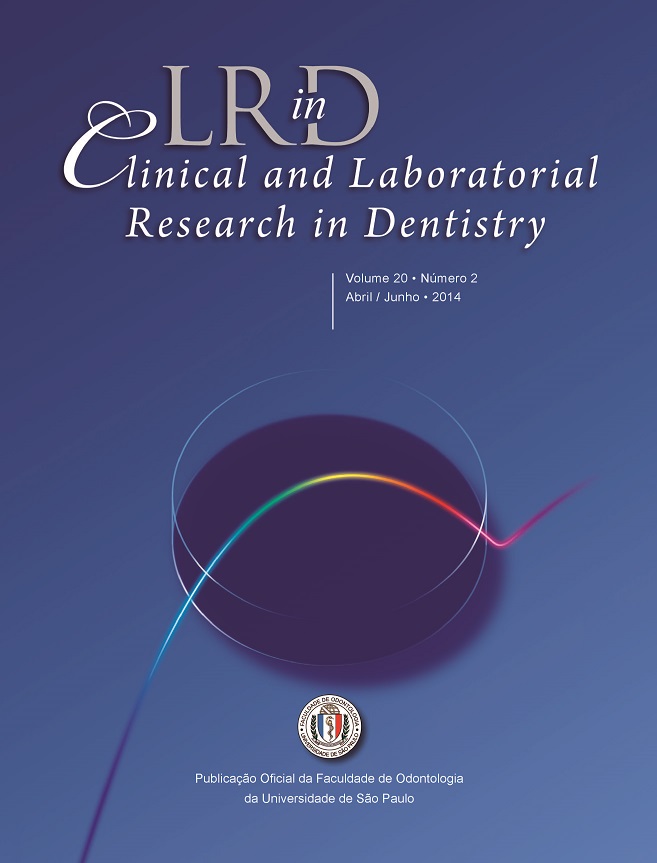Bonding of permanent tooth fracture without pulp exposure: a case report
DOI:
https://doi.org/10.11606/issn.2357-8041.v20i2p110-116Keywords:
Tooth Injuries, Incisor, Dental Bonding, Esthetics, Dental.Abstract
Dental trauma is a serious oral health problem which is prevalent in the population, especially in children with protrusion of the maxillary incisors. Enamel and dentin combined fractures are the most prevalent among permanent tooth fractures. Bonding of the fractured tooth is described as an alternative therapy for fractured teeth; however, it involves factors that infl uence treatment success: the existence of the tooth remainder, the time elapsed between trauma and treatment, the involvement of enamel, dentin and pulp chamber, and the bonding technique. This study was conducted in the undergraduate clinic of the Discipline of Pediatric Dentistry, School of Dentistry, University of Sao Paulo, and describes a simplifi ed bonding technique applied to a combined enamel and dentin fracture of a right maxillary central incisor, without pulp involvement, in a nine-year-old male child. The importance of patient management, proper indication, therapy limitations, prognosis and follow-up are also discussed in this study.Downloads
References
Chazine M, Sedda M, Ounsi HF, Paragliola R, Ferrari M, Grandini S. Evaluation of the fracture resistence of reattached incisal fragments using different materials and techniques. Dental Traumatology. 2011 27(1):15-18.
Macedo GV, Diaz PI, Fernandes CAO, Ritter AV. Reattachment of Anterior Teeth Fragments: a Conservative Approach. J Esthet Restor Dent. 2008 20(1): 5–20.
Wiegand A, Rödig T, Attin T. Treatment of crown fractured incisors: reattachment instead of restoration? Schweiz Monatsschr Zahnmed. 2005 115(12): 1172-81.
Quin M. Pulp treatment of young permanent teeth after traumatic dental injury. Hua Xi Kou Qiang Yi Xue Za Zhi. 2009 27(3):237-40.
Altum C, Ozen B, Esenlik E, Guven G, Gurbuz TK, Acikel C, Basak F, Akbulut E. Traumatic injuries to permanent teeth in Turkish children, Ankara. Dent Traumatol. 2009 25(3): 309–13.
Pujita C, Nuwula S, Shilpa G, Nirmala S, Yamini V. Informative promotional outcome on school teachers’ knowledge about emergency management of dental trauma. J Conserv Dent. 2013 Jan 16(1):21-7.
Turkistani J, Hanno A. Recent trends in the management of dentoalveolar traumatic injuries to primary and young permanent teeth. Dent Traumatol. 2011 Feb 27(1):46-54.
Lehl G, Luthra R. Reattachment of fractured fragments of maxillary central incisors: report of case. J Indian Soc Pedod Prev Dent. 2004 22(2): 54-55.
Goenka P, Dutta S, Marwah N. Biological approach for management of anterior tooth trauma: triple case report. J of Indian Soc Pedod and Prev Dent. 2011 29(2):180-86.
Demarco FF, Moura FRR, Tarquinio SBC, Lima FG. Reattachment using a fragment from an extracted tooth to treat complicated coronal fracture. Dent Traumatol. 2008 24(2): 257–61.
Downloads
Published
Issue
Section
License
Authors are requested to send, together with the letter to the Editors, a term of responsibility. Thus, the works submitted for appreciation for publication must be accompanied by a document containing the signature of each of the authors, the model of which is presented as follows:
I/We, _________________________, author(s) of the work entitled_______________, now submitted for the appreciation of Clinical and Laboratorial Research in Dentistry, agree that the authors retain copyright and grant the journal right of first publication with the work simultaneously licensed under a Creative Commons Attribution License that allows others to share the work with an acknowledgement of the work's authorship and initial publication in this journal. Authors are able to enter into separate, additional contractual arrangements for the non-exclusive distribution of the journal's published version of the work (e.g., post it to an institutional repository or publish it in a book), with an acknowledgement of its initial publication in this journal. Authors are permitted and encouraged to post their work online (e.g., in institutional repositories or on their website) prior to and during the submission process, as it can lead to productive exchanges, as well as earlier and greater citation of published work (See The Effect of Open Access).
Date: ____/____/____Signature(s): _______________


